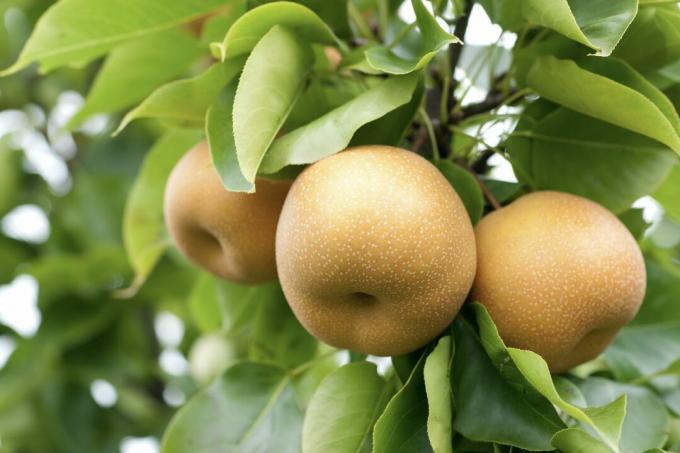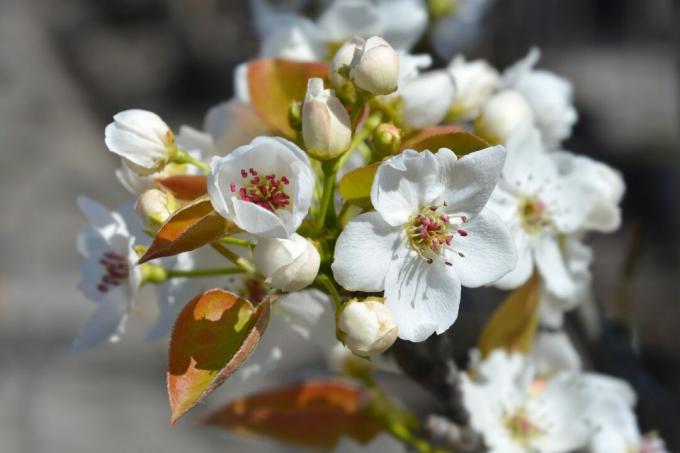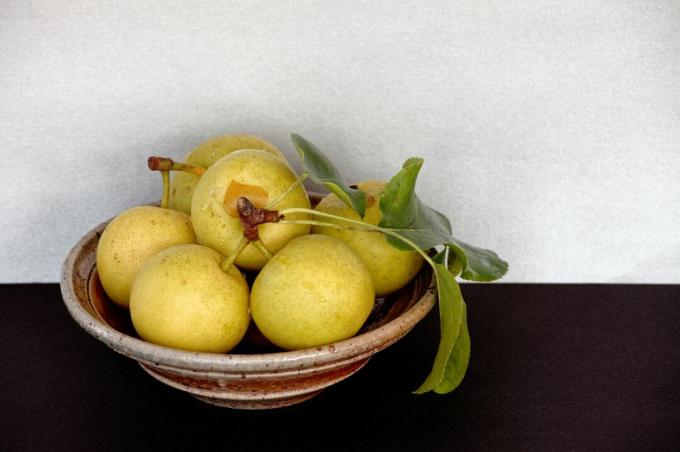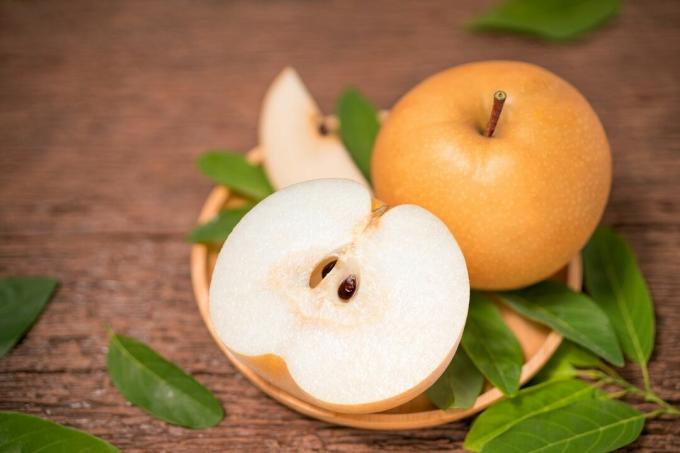The exotic Nashi pear, also known as Chinese, Asian or Japanese pear, can also be grown in Germany. In the following you will find out how this works and what else you should pay attention to when caring for the tree.

The Nashi pear, also called Chinese pear, is a close relative of our cultivated pear (Pyrus communis) and thrives in our gardens too. We will introduce you to the Asian fruit trees and give you tips on cultivation and harvest.
"Contents"
- Nashi pear: origin and characteristics
- Overview of the Nashi pear varieties
-
Plant nashi pear
- The right location for the Nashi pear tree
- Planting a Nashi pear: this is how it works
- Caring for the Chinese pear: what to watch out for
- Propagate the nashi pear
- Harvest and store Nashi pear
Nashi pear: origin and characteristics
Where does the nashi pear come from? The nashi pear (Pyrus pyrifolia) belongs to the rose family (Rosaceae) and originally comes from China, but is now widespread throughout East Asia and Japan. The word “Nashi” comes from Japanese and means “pear”, which is why the term “Nashi pear” is actually a double. The Nashi is a hardy, medium-strong growing tree that can reach a height of 7 to 15 m as a high trunk. Varieties for home gardens or commercial cultivation are significantly slower and usually only reach a maximum height of 5 m and a width of 2 to 4 m. The flowering time of the Nashi pear begins in April, with the many white flowers providing food for numerous insects. For good pollination, Nashis need a second tree, or alternatively a pollinating pear variety such as
"Conference" or ‘Williams Christ’. The apple-shaped, flat-round fruits have large, light-colored lenticels and can be completely rusty. The diameter of a fruit is between 6 and 10 cm. The color varies between yellow-green and sun-yellow to bronze in the rusted varieties. Nashis ripen in late summer between August and October. They taste fruity-sweet and very juicy, like melon and a little pear. The harvest time of the Nashi pear lasts for about a month.
Overview of the Nashi pear varieties
Especially in Asia, the Nashi is also cultivated in plantations, which is why most of the varieties available come from East Asian breeding. We give an overview of ten attractive Nashi varieties for your own garden.
- ‘Benita’: Cross between European pear and Nashi. The tree, which is up to 4 m high, grows vigorously. ‘Benita’ ripens from August and tastes more pear-like than pure Nashi varieties. The fully ripe fruits fall down, so they should be harvested beforehand.
- ‘Chojuro’: Medium to fast-growing Nashi with large, attractive dark bronze-colored, rusty fruits. The coarse-grained pulp is perfumed and juicy, sweet. The variety ripens medium early and can be harvested from September.
- ‘Hakko’: Nashi pear with weak growth and yellow-green to golden yellow, medium-sized fruits. The harvest of the sweet and aromatic Nashi pear begins at the end of August.
- ‘Hosui’: Medium-strong growing variety with medium-sized fruits with an attractive bronze tone. The juicy flesh is perfumed and fine-grained. The Nashi can be harvested from September.

- ‘Kumoi’: Nashi pear with light bronze fruits and medium-strong growth. The 4 - 5 m high tree of ‘Kumoi’ bears ready-to-pick Nashis between September and October.
- ‘Naddel Pear’: French variety with 3 - 4 m height and from September ripening light yellow, juicy-sweet fruits.
- ‘Nijisseiki’: Nashi pear with strong growth and yellow-green, medium-sized fruits. The aromatic nashis can be harvested from September.
- ‘Reddy Robin’: New Zealand variety from a cross between a Chinese and Japanese Nashi with fruit that is red speckled on the sun-side. ‘Reddy Robin’ is scab-resistant and can be harvested from the end of August.
- ‘Shinseiki’: Medium to strong-growing tree and medium-early harvest time from September. The yellow fruits are the result of crossing the varieties ‘Nijisseiki’ and ‘Chojuro’.
- ‘Yakumo’: Low-growing tree for small gardens. The yellow-green fruits are significantly smaller than in other Nashi varieties, but have a very good fruit quality and an aromatic taste. ‘Yakumo’ ripens after ‘Nijisseiki’ from around mid-September.

Plant nashi pear
Fruit trees like the Nashi pear are ideally planted in late autumn. The best time to plant is between October and November, as the tree forms new roots through winter, but does not yet lose water through the leaves. In the following spring a fine root system has already formed, which supplies the Nashi pear tree with water and nutrients. With a growth width of 2 to 4 m, the Asian pear should have a distance of at least 2 to 2.5 m to other plants. However, there are also Nashi pears as column fruit with a much narrower growth shape and correspondingly less space requirements.
The right location for the Nashi pear tree
Nashi pears place similar demands on the location as cultivated pears. The Asian pear thrives best on well-drained, deep and humus-rich garden soils in a sunny location. The pH value should be in the slightly acidic range.
Planting a Nashi pear: this is how it works
The deep-rooted nashi pears should be planted and tied well. Proceed as follows to plant the Asian fruit trees:
- Dig a large planting hole, at least 1.5 times the size of the nashi root ball.
- Excavated soil with ripe compost or if necessary Plantura organic soil activator mix.
- Place the Nashi pear tree in the planting hole, the grafting point must be about 10 cm above the surface of the earth.
- Fill up with soil mixture, press soil all around, form the pouring rim and water well.
- Hit two pegs against and with the wind direction and fix Nashi in between.
- Final planting pruning for a good crown structure: Reduce the side shoots to three to four branches and cut them by half. Shorten the main shoot so that it is no more than 10 cm higher than the side branches.
Caring for the Chinese pear: what to watch out for
In the first year after planting, the Nashi tree should be watered during dry periods. An annual fertilization in spring supplies the fruit tree with important nutrients. Nashis should also be given a good education and rejuvenation, as they often age faster than cultivated pears. When cutting nashi pears, one can feel good at Pear tree cut orientate. Branches that rise steeply can be brought into a horizontal position with weights or ropes. This promotes flower formation and a rounded crown. Compared to many fruit trees, Nashis are more robust against pests. So they are largely insensitive to it Pear grid (Gymnosporangium sabinae) and Apple scab (Venturia inaequalis). However, the reportable person can do so Fire blight (Erwinia amylovora) and the pear decay (Candidatus Phytoplasma pyri) occur that can cause entire trees to die. Wasps and birds also like nashi pears and can eat many of the tasty fruits.

Propagate the nashi pear
Nashis can be propagated via seeds or grafting via calyx. When planting the Nashi pear kernels, you should note that they are cold germs, which require a longer cold period before germination. However, seedlings only bear fruit after several years. Certain varieties cannot be propagated from seeds, as Nashis mostly interbreed with pears. They should be grafted onto other Nashis. Also quince (Cydonia oblonga) and pear are suitable bases on which to refine the Nashi pear. This technique also enables garden owners to refine an existing tree and thus transform a branch or part of the crown into a nashi. In our article on the Grafting apple trees you can learn more about different techniques that are also applicable to pear and nashi.

Harvest and store Nashi pear
Nashi pears ripen from August to October. You should always keep an eye on the fruits, as they are hard at first and then soften very quickly. The taste of the Nashi pear is juicy-sweet and aromatic with a pear aroma. For direct consumption, the Chinese pears are harvested shortly before they are fully ripe, so that they are still crisp, but no longer hard. Ripe Nashi pears should be used quickly. They can be processed into juice, jam or pear chips and thus preserved. Hard fruits harvested shortly before they are fully ripe can be stored in the refrigerator or cool cellar for around two months and eaten gradually.
How healthy is the nashi pear? The healthy Nashi pear has similar ingredients to our culture pear, but is richer in vitamins, as well as potassium and magnesium. These minerals are particularly important for maintaining normal muscle function. It also contains vitamin C, various B vitamins and provitamin A.
Like many of our fruits, including apples and pears, the related one is also sourced Medlar (Mespilus germanica) originally from Asia. In our article you will find out everything about the choice of varieties, cultivation and harvest of the delicious wild fruit.
